
Just a teaser of the next post!

Just a teaser of the next post!
I’m just bouncing around in happiness since I discovered this morning that Mama Screech Owl is back, and it looks like she’ll soon have babies fledging — she can barely fit in her house! It seems Austin is having a great Eastern Screech Owl year — almost everyone I know has at least one occupied house! Which is why I was feeling so very jealous and also so very worried that something had happened to our mama lady. But there she be!
 She switched houses, too — opting for the house in the back of the yard instead of the side. I think it was a fine choice for her to select the other apartment — a woman always has the right to change her mind and also to rearrange furniture! Or in this case, just plain move. Though she’s on a tree that sways in the wind a lot more, she sure gets a good view of everything going on in the yard.
She switched houses, too — opting for the house in the back of the yard instead of the side. I think it was a fine choice for her to select the other apartment — a woman always has the right to change her mind and also to rearrange furniture! Or in this case, just plain move. Though she’s on a tree that sways in the wind a lot more, she sure gets a good view of everything going on in the yard.
Once again, her appearance has mysteriously coincided with fewer toad calls at night. I get the feeling that she LOVES our wildlife garden for all the food it provides her and her babies. One of these days, maybe I’ll get to see Papa Owl!
As if that weren’t enough, I also found our first Pipevine Swallowtail caterpillars, hatched from eggs that a surprise female butterfly deposited a few weeks ago, and an Orange Sulphur caterpillar on our Lindheimer’s Senna, too! Oh happy day!
I was out working in the garden this afternoon when I was happily driven back inside by RAIN!
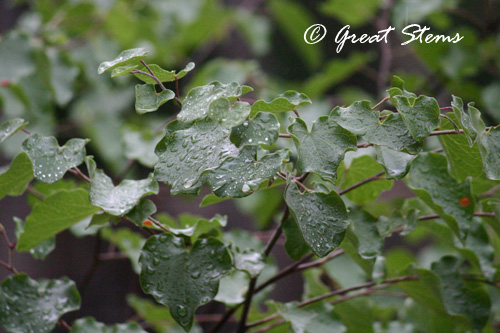 I stopped to do my happy rain dance, then I figured I might as well take a moment to finish the blog post I started yesterday. So…
I stopped to do my happy rain dance, then I figured I might as well take a moment to finish the blog post I started yesterday. So…
I grew artichokes… again. I didn’t manage to eat them… again. I missed that window between “not ready to be harvested” and “you blew it, the ideal picking time is over.” I can’t remember what was going on– maybe Earth Week (busy at my son’s school) — but whatever it was, the artichokes declined to postpone their harvest date for me. However, sometimes such vegetable garden tragedies can lead to something good.

In this case, I discovered that artichokes left to flower produce a gigantic lavender bloom worthy of their prehistoric-looking foliage.
 It’s giant, it’s purple, it’s spectacular, and it’s in my garden! The bees love it. They dig deep past the petals to reach the pollen, and their cute little bee butts stick out. I wish I’d caught a picture.
It’s giant, it’s purple, it’s spectacular, and it’s in my garden! The bees love it. They dig deep past the petals to reach the pollen, and their cute little bee butts stick out. I wish I’d caught a picture.
 A lone male monarch stopped by — I was glad to be able to offer it nectar beverages, as its wings were not in the best of shape. It looked like the wings had been that way since emerging from the chrysalis. Poor thing, that must make flying long distances a challenge.
A lone male monarch stopped by — I was glad to be able to offer it nectar beverages, as its wings were not in the best of shape. It looked like the wings had been that way since emerging from the chrysalis. Poor thing, that must make flying long distances a challenge.

Above, the monarch rests on Purple Coneflower, which are the tallest they ever been, not that you can tell from the picture. But I know this to be true — third year’s a charm!
The hummingbirds are busy, busy. They are in full feisty mode, with the males going at each other to lay claim on the feeders, while the females sneak in for a drink.

We hung a new feeder on the patio — it’s so pleasant to sit and relax and have the hummers come hang out with us.

We’ve had numerous fledglings visiting the feeders. This young male cardinal is rather mottled-looking as it transitions to its bright red colors.
 See its dark beak? Baby cardinals’ beaks start out dark, then become orange as they get a little older.
See its dark beak? Baby cardinals’ beaks start out dark, then become orange as they get a little older.
Our baby owl has fledged, by the way. We knew that Screech Owls fledge soon after they appear at a cavity’s entrance, but that didn’t stop us from hoping our little cutie would hang around for awhile. Here’s the last picture I took of it on the day it fledged.
 Fly well, little Screech Owl!
Fly well, little Screech Owl!
Like expectant grandparents, we’ve been eagerly keeping an eye on our owl house for two months or so. We’ve had an owl watching us almost every day, and I even went so far as to complain about how she didn’t ever do anything except watch us every day.
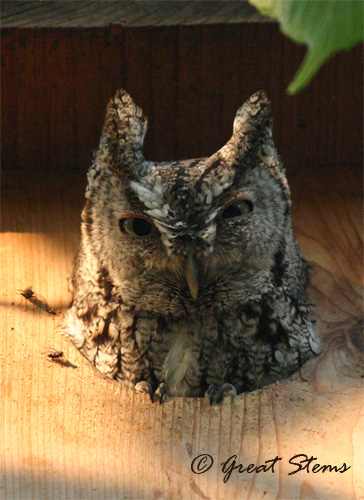
Because she never seemed to move, we couldn’t really predict whether she had a baby in the box with her. We also never noticed a second owl around, no matter how hard we tried to search for it. We were starting to think we’d built a bachelor(ette) pad instead of an owl nursery.
As it turns out, our resident owl was, in fact, taking care of her young. Today we got our first real glimpse of her baby.
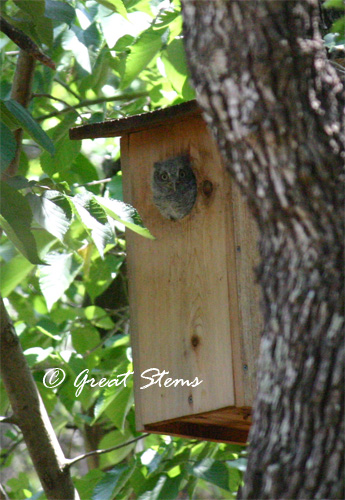
The little one was definitely skittish, so I took my time approaching it for its first photo op.
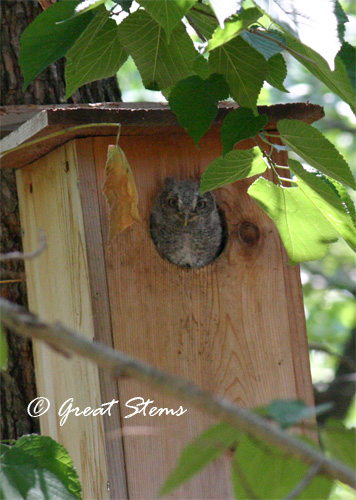
It’s already sporting some tufts. From what I’ve read, we should expect it to fledge fairly quickly.

Could there be another baby or two in the nesting box? Whoooo knows? But we’ll be on the lookout!
Say what?!!
 That owl up there is driving us crazy, though I’m sure it would say the same about us. All day long it sticks its head out of the nesting-box hole and does NOTHING. Nothing except occasionally stick its head out farther to see what we’re up to in the yard (which usually is us sticking our heads around trees to see what the owl is doing). Just go ahead and show us some baby owlets or bring in a rat or make an eerie screech owl noise or something, would you? We’re so happy our screech owl is here, but it’s just weird that it hangs out of the hole all day long.
That owl up there is driving us crazy, though I’m sure it would say the same about us. All day long it sticks its head out of the nesting-box hole and does NOTHING. Nothing except occasionally stick its head out farther to see what we’re up to in the yard (which usually is us sticking our heads around trees to see what the owl is doing). Just go ahead and show us some baby owlets or bring in a rat or make an eerie screech owl noise or something, would you? We’re so happy our screech owl is here, but it’s just weird that it hangs out of the hole all day long.
 That being said, I have a feeling I’ve been unnecessarily blaming our frogs for causing the odd shortage of our once-abundant toads. Most likely I should be blaming the screech owl. After all, we’ve apparently set up a rather nice buffet table for the owl, which watches over the pond from its vantage point up in the nesting box. The male toads come out at night, innocently croaking loudly to attract a potential mate, and it’s just possible that their call instead acts like a beacon to bring the silent predator from above right to them.
That being said, I have a feeling I’ve been unnecessarily blaming our frogs for causing the odd shortage of our once-abundant toads. Most likely I should be blaming the screech owl. After all, we’ve apparently set up a rather nice buffet table for the owl, which watches over the pond from its vantage point up in the nesting box. The male toads come out at night, innocently croaking loudly to attract a potential mate, and it’s just possible that their call instead acts like a beacon to bring the silent predator from above right to them.

Check out who this green frog is watching — someone better be careful!
Of course, it’s entirely possible the pond frogs really are to blame — they are certainly not above cannibalizing (toads are actually frogs, you know, and frogs will eat frogs). It appears we have created the ultimate frog haven in our hot-tub pond. The frogs spread themselves out across the water (so as to not get too close to their hungry neighbor, I assume), and then they wait for whatever moving morsel dares to venture close. I’m still trying to determine the species we have — at the very least, we have both American Bullfrogs and Southern Leopard frogs, but the markings are odd on a couple of them.
And they are all getting big. The largest bullfrog is getting downright scary (cue “Jaws” music).



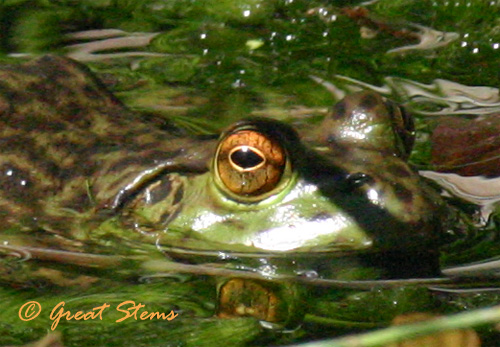 I still have to get in the pond to get acorns and such out of it — my spring cleaning is way overdue — don’t I look forward to it with Gigantic Freaka-Frogazoid there joining me! I’m just kidding — I love frogs.
I still have to get in the pond to get acorns and such out of it — my spring cleaning is way overdue — don’t I look forward to it with Gigantic Freaka-Frogazoid there joining me! I’m just kidding — I love frogs.
 Of course, also on the toad hunt might be this Checkered Garter Snake — it has a perfect waiting spot among the pond rocks. Our garden habitat is an ecosystem at work, that’s for sure. All the same, I suggest all toads immediately head to our front-yard pond. It’s smaller, but a little toad-safer for the time being.
Of course, also on the toad hunt might be this Checkered Garter Snake — it has a perfect waiting spot among the pond rocks. Our garden habitat is an ecosystem at work, that’s for sure. All the same, I suggest all toads immediately head to our front-yard pond. It’s smaller, but a little toad-safer for the time being.
Here’s one toad we found alive and well — hop and hide, little one! Hop and hide!


Nearby, a cardinal flew in for a seed and a close-up. Blue Jays splash in the birdbaths, hummingbirds dance in sync together, doves play follow-the-leader… and still our screech owl sits in its nesting-box hole.
 All around town, the wildlife and native plants are doing their best to handle drought conditions. Check out this beauty seen at McKinney Roughs — it’s a Great Purple Hairstreak.
All around town, the wildlife and native plants are doing their best to handle drought conditions. Check out this beauty seen at McKinney Roughs — it’s a Great Purple Hairstreak.
 Don’t see any purple on it? That’s because there isn’t any. By the way, this little beauty’s host plant is Mistletoe — consider it a plus side to the parasitic plant.
Don’t see any purple on it? That’s because there isn’t any. By the way, this little beauty’s host plant is Mistletoe — consider it a plus side to the parasitic plant.
This next image is of a beautiful little Southern Emerald Moth — however, its wings were up instead of laying flat, and it didn’t seem able to fly, poor thing. This is the second time I’ve seen this moth in the same condition at the same locale, Hornsby Bend.

 The Retamas (also called Jerusalem Thorn) lining the ponds at Hornsby Bend are in full bloom right now. These airy-yet-thorny native Texas plants tend to spread when they get plenty of water, but the bees and birds sure love them. It’s understandable. Beautiful yellow blooms and thorns for protection — sounds great to me.
The Retamas (also called Jerusalem Thorn) lining the ponds at Hornsby Bend are in full bloom right now. These airy-yet-thorny native Texas plants tend to spread when they get plenty of water, but the bees and birds sure love them. It’s understandable. Beautiful yellow blooms and thorns for protection — sounds great to me.
 Bees, generally speaking, do love the color yellow. Bees visiting Prickly Pear blossoms go a little crazy with it — they act almost drunk.
Bees, generally speaking, do love the color yellow. Bees visiting Prickly Pear blossoms go a little crazy with it — they act almost drunk.

 But the winner of the bee-attracting flowers right now is the blooming century plant down at Natural Gardener.
But the winner of the bee-attracting flowers right now is the blooming century plant down at Natural Gardener.
 I think several hives of honeybees came to visit.
I think several hives of honeybees came to visit.
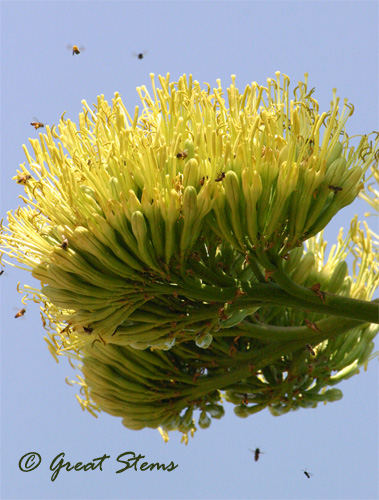
Too bad I couldn’t climb up there to get a closer look. To put the height in perspective, take a look at this:

Time to get back out in the garden while the temperatures are still pleasant with our temporary cold front — hopefully more wildlife will join me!
This morning I headed south to join a group of birders at the Wildflower Center. Since I don’t have a dedicated set of binoculars (yet), I can’t officially call myself a “real” birder, based on my personal definition, but given that I got up at 6am to drive across town to trek along trails and into woods to find our avian friends, I guess I might as well stop fooling myself. Our guide Travis loaned me a set of binoculars, though — thank goodness, because my zoom lens only goes so far. Note to self: Add birding binoculars to my wish list. Might as well add a bigger zoom to that list, too.
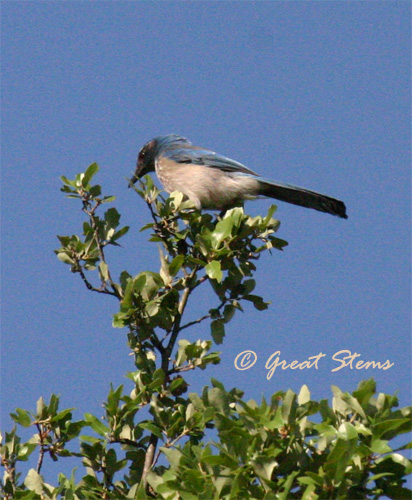
Western Scrub-Jay
Today we hoped to see the Painted Buntings that have arrived at the Wildflower Center, but of course we took a full walk around to see as many birds as possible. The key to finding a bird on a wildlife walk among trees and shrubs is to keep a keen eye watching for movement and a careful ear listening and distinguishing bird calls. Even then, there’s no guarantee you’ll see what the person next to you caught a mere glimpse of, and there were several birds we never saw at all but only heard. There’s a whole trick to finding birds through binoculars, too.
Northern Cardinals and Northern Mockingbirds greeted us the most with song, though I suspect it had far less to do with us and far more to do with their mates.

Among the 30 species of birds we caught glimpses of or recognized the sounds of were White-Eyed Vireo, Bewick’s Wren, Downy and Ladder-Backed Woodpeckers, Brown-Headed Cowbird, Lesser Goldfinch, Cooper’s Hawk, Estern Phoebe, Bobwhite Quail, and oh so many more.
As hard as it was to find the birds, even with binoculars, it was even harder to get a picture with the camera. Here is the only evidence I have of the Black-Throated Green Warbler we saw — it moved just as I got into position to get a photo:

This next pitiful picture hides a Yellow Warbler. See it?

Alas. At least the nearby flowers cooperated. You know me, I couldn’t help but appreciate the beauty of the flowers while I listened to the birds.

Above, the ever-beautiful Purple Coneflowers commanded attention from their blue backdrop of Mealy Blue Sage, and below, a bee took a pollen bath in a Winecup.

A Carpenter Bee took a rest on Antelope Horn Milkweed.
 But I digress.
But I digress.
The Great Horned Owlets continue to do well, and we took a few moments to visit them, being cautious not to linger too long.
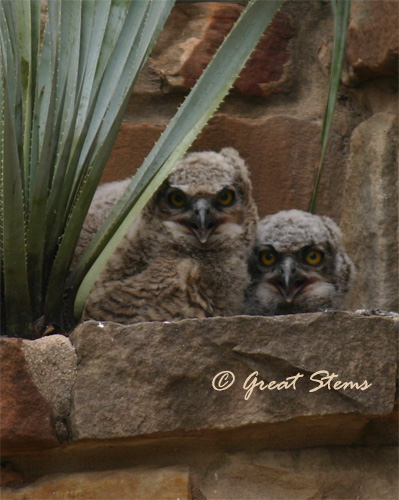 There are three of them, but the prime hiding spot is behind the sotol, so capturing a picture of all three at once was a challenge. I felt lucky to get “the eye” of the third.
There are three of them, but the prime hiding spot is behind the sotol, so capturing a picture of all three at once was a challenge. I felt lucky to get “the eye” of the third.
 I’m cheating here — the above images and the one below I actually took two days ago during another visit to the Center — look how big the owls are growing. I think the one standing tall in the image below might actually be the youngest baby — see how the others are farther developed in their plumage? The Center’s staff is keeping an extra watch on it.
I’m cheating here — the above images and the one below I actually took two days ago during another visit to the Center — look how big the owls are growing. I think the one standing tall in the image below might actually be the youngest baby — see how the others are farther developed in their plumage? The Center’s staff is keeping an extra watch on it.
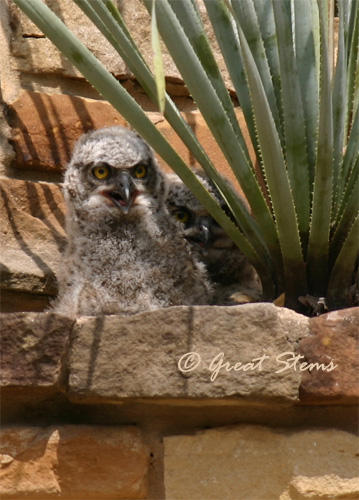 Now take a look at the owls this morning. With the cooler temperature, they were fluffed up, but what a difference in plumage two days can make.
Now take a look at the owls this morning. With the cooler temperature, they were fluffed up, but what a difference in plumage two days can make.
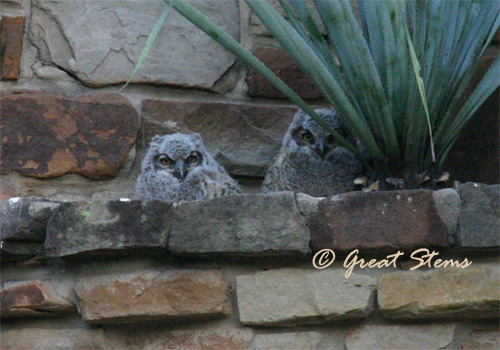
We didn’t see Mama Owl (or Papa Owl, for that matter), but I’m sure she was watching us from afar. She no longer stays in the nest with her babies — they are so big! — but she continues to feed them during off hours.
As for Painted Buntings, we heard several but only saw a couple from quite far away. They just didn’t care to let us get close. This very-zoomed-in photo, my friends, is the best I have to show you.
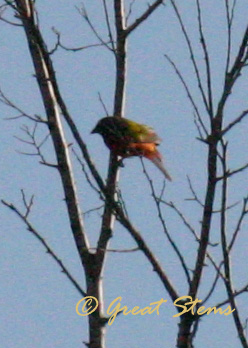 But we saw them — that’s what counts!
But we saw them — that’s what counts!
While enjoying the Austin Yard Art Tour this weekend, the boys and I zipped down to the Wildflower Center to see the nesting Great Horned Owl mama and her babies.

Mama was dozing lightly, staying cautious of the visitors snapping pictures below.
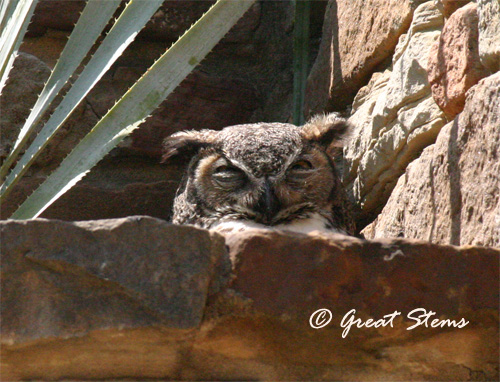 After a few minutes, we caught a glimpse of a white fuzzball making an appearance.
After a few minutes, we caught a glimpse of a white fuzzball making an appearance.

 Make that an adorable white fuzzball. There are three owlets with mama, but the other ones stayed asleep during our visit.
Make that an adorable white fuzzball. There are three owlets with mama, but the other ones stayed asleep during our visit.

Thanks, Mama Owl, for letting us visit your babies!
Edit: Pam of Digging got pictures of the babies during her recent visit — apparently mama owl was out hunting. So cute!
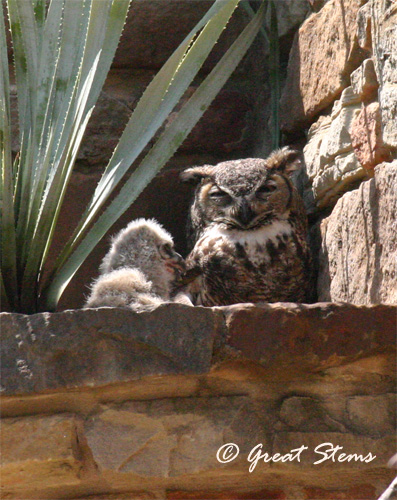 Despite the short post today, it took me a little while to put it together. I decided to put on the Eagle Cam while I was working and kept getting distracted with eaglets getting their breakfast from mom.
Despite the short post today, it took me a little while to put it together. I decided to put on the Eagle Cam while I was working and kept getting distracted with eaglets getting their breakfast from mom.
Pictures coming soon of some Yard Art favorites from the tour! Austin is definitely weird, and I have proof.
It’s been an emotional time in the bird world of our habitat. First we were concerned we’d accidentally startled away our Screech Owl resident during a well-meant daytime branch pruning. But happily the owl returned and is once again watching over all backyard activity.


I’m hopeful that the owl being so quick to flush might actually indicate that there are babies in there, but really I’m just looking for any sort of sign at all that we might get to see baby owls at some point soon. For all we know, we’ve just got one extremely comfortable bachelor hanging out in his awesome pad.

The other owl house has become occupied by a squirrel and most likely its family, and well, that’s not such a good thing, as you’ll find out shortly.
Very exciting is that we recently enjoyed a flock of migrating birds all taking baths together in the waterfall of our pond. They arrived together and left together — I invited them to stay but they clearly had places to go after they got all clean. They wouldn’t let me get too close for pictures, but as long as I was a safe distance away, they splashed about eagerly.

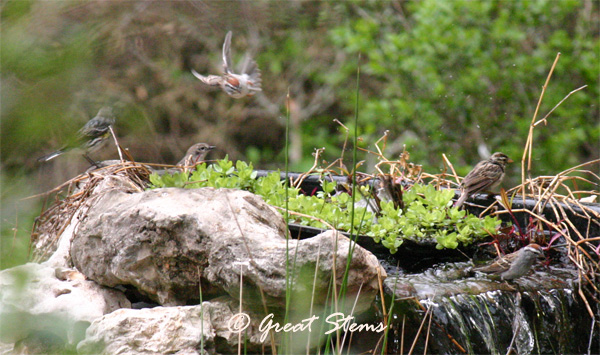 We had Chipping Sparrows, Yellow-Rumped Warblers, one Ruby-Crowned Kinglet–
We had Chipping Sparrows, Yellow-Rumped Warblers, one Ruby-Crowned Kinglet– I’m still working on IDing the rest. There’s another sparrow in there, and that yellow bird looks like something other than a finch — possibly another kind of warbler and one Nashville Warbler (this yellow bird is new to me — Audubon gurus Jane T. and Laurie F. identified it for me — thank you both!). Even Carolina Chickadees (not pictured) and White-Winged Doves (also not pictured) flew down to join in. Safety in numbers, I suppose — plenty of birds to look out for danger while the rest splash about.



Some bathed in the waterfall plants, while others went straight to the waterfall.
 The flock was only here but briefly, but those few minutes made us so happy that we had a waterfall to offer them.
The flock was only here but briefly, but those few minutes made us so happy that we had a waterfall to offer them.
 But today we feel sad, because yesterday afternoon our young Carolina Wren babies were snatched away. We are blaming the squirrel seen in the vicinity during the hour when it must have happened, as we had just prior checked on the babies and they were all there. I had no idea that squirrels would eat baby birds until that happened. It’s upsetting, but it’s nature. Plants provide food for animals, who in turn become food for larger animals, and so forth. That’s why I don’t hang out with saltwater crocodiles.
But today we feel sad, because yesterday afternoon our young Carolina Wren babies were snatched away. We are blaming the squirrel seen in the vicinity during the hour when it must have happened, as we had just prior checked on the babies and they were all there. I had no idea that squirrels would eat baby birds until that happened. It’s upsetting, but it’s nature. Plants provide food for animals, who in turn become food for larger animals, and so forth. That’s why I don’t hang out with saltwater crocodiles.
But even though it’s all the circle of life, I’m not thinking squirrels are so “cute” anymore. They were clearly setting me up, doing all their silly antics and making those innocent faces! Then they go and eat the baby birds I’d been daily protecting and documenting the growth of. But while my habitat is songbird-friendly and apparently a squirrel’s delight, it’s also owl-friendly. Squirrels might be on the larger side of a Screech Owl’s diet, but they are definitely on the menu. So those squirrels better realize they are in prime viewing range of that which might eat THEM.
Speaking of owls, if you have a chance to visit the Wildflower Center, be sure to take your camera. There’s a Great Horned Owl nesting right where visitors can stop and say hello.

Apparently her big-eyed owlet is peeking out now, too — if I can, I’m going to head down there to get a picture! I’m going to venture a guess that this baby is safe from squirrels….
One of our screech owl houses has a new occupant. For the first few days, it was quite difficult to capture a picture of her — she was reluctant to stay visible when we were in the backyard. But each day she’s watched us for longer period of times and seems to realize we’re not going to fly up there after her.
 This afternoon she let me approach quite near her, not even bothering to watch me like
This afternoon she let me approach quite near her, not even bothering to watch me like a hawk an owl. In fact, she closed her eyes and snoozed for some of the time I was taking pictures.
 You can tell in the pictures that she’s backlit by the sun in the afternoons — I keep trying to get a picture of her in the morning, but she always seems to prefer getting right to sleep after a night’s hunt. What’s up with that?!!
You can tell in the pictures that she’s backlit by the sun in the afternoons — I keep trying to get a picture of her in the morning, but she always seems to prefer getting right to sleep after a night’s hunt. What’s up with that?!!

She’s also the most vocal owl we’ve had to date. Either that, or she’s got a male trying to get her attention — ooh, I hope so!

 Correction to my last post — it’s official — both our owlhouses are occupied. Camera in hand, I ventured back into the yard at dusk to see whether I could get any shots of a more active owl. Well, this time Mrs. Owl made her appearance at the front owlhouse. For confirmation that it was a different owl, I checked the other house in the back of the yard. Sure enough, the owl I photographed earlier was still there. We have two!
Correction to my last post — it’s official — both our owlhouses are occupied. Camera in hand, I ventured back into the yard at dusk to see whether I could get any shots of a more active owl. Well, this time Mrs. Owl made her appearance at the front owlhouse. For confirmation that it was a different owl, I checked the other house in the back of the yard. Sure enough, the owl I photographed earlier was still there. We have two!
I’m guessing this is an owl couple, given the size difference between the two birds. Mrs. Owl really filled up the doorway.
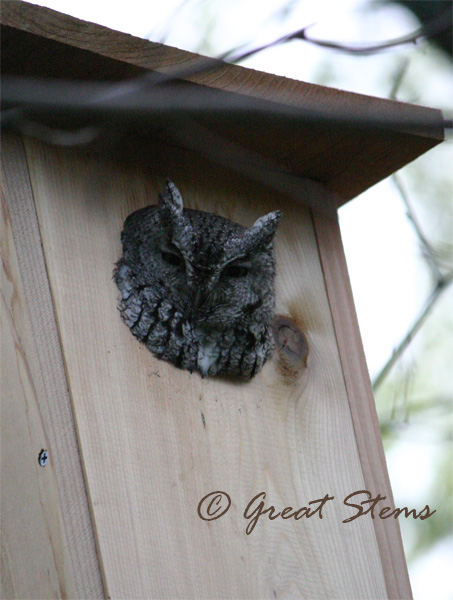
 If this really is an owl couple we’ve got occupying our two owl houses, then it supports the idea that having two houses is more likely to attract owls sooner. It sure worked in our case.
If this really is an owl couple we’ve got occupying our two owl houses, then it supports the idea that having two houses is more likely to attract owls sooner. It sure worked in our case.
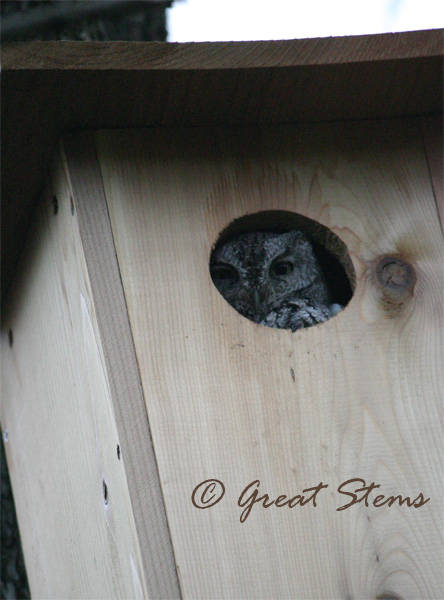
Mrs. Owl didn’t seem to mind me too much, until I apparently took one step too close. She’s a beauty, though. My favorite is the side view of her. She’s big for a little thing!